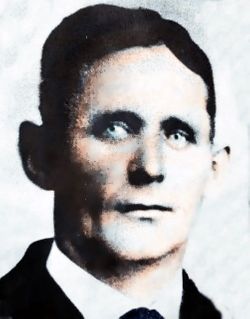William E. Swartz was born on July 18, 1870, in Lehighton, Pennsylvania. Son of Henry Swartz and Matilda Elizabeth Remsley. A respected railroad contractor by trade and a dedicated public servant, William rose to serve as the Chief of Police in his hometown, a position he held with pride and commitment until his untimely death in 1917.

Early Life and Family
William spent his youth in the Mahoning area of Carbon County, Pennsylvania, where he grew up surrounded by the industrious spirit of the coal and railroad industries that shaped the region. At the age of 19, on November 24, 1889, William married, starting a family that would grow over the next two decades.
He and his wife raised several children:
-
Frank J. Swartz (1890–1910)
-
Harriet Esther Swartz (1890–1943)
-
Robert Allen Swartz (1891–1966)
-
Laura A. Swartz (1893–1972)
-
Thomas Daniel Swartz (1896–1974)
-
Wilmer Henry Swartz (1899–1984)
-
Helen Elizabeth Swartz (1904–1985)
-
Paul Edgar Swartz (1907–1992)
-
Grace Mildred Swartz (1911–2001)
Despite personal hardships, including the loss of his mother, Matilda Elizabeth Remsley, in 1893, William remained a steadfast family man and community figure.
Service as Chief of Police
William’s dedication to public safety culminated in his appointment as Chief of Police for Lehighton. He was known for his steady leadership, earning a salary increase in early 1917 from $50 to $70 per month—a recognition of his service and responsibilities.
His tenure coincided with the challenging times of rapid industrial growth and social change, where maintaining law and order was no easy task. William balanced his role with his previous experience as a railroad contractor, deeply understanding the community’s working-class fabric.
Tragic Death and Aftermath
On May 2, 1917, tragedy struck. Chief Swartz was shot by Frank (Francis Leo) Clark, a railroader known to be a tough and notorious figure. The bullet lodged against his spine, and despite efforts to save him, William succumbed to his injuries on May 3, 1917, at the age of 46.
The news shocked Lehighton and surrounding communities. His funeral was held on May 7, 1917, drawing mourners who respected his service and mourned the violent loss.
Frank Clark fled but was soon captured after a tense manhunt spanning several Pennsylvania counties. He was arrested in Dubois on May 13, 1917, unaware at the time that Chief Swartz had already passed away.
During his trial, Clark was reportedly remorseful and visibly emotional, collapsing in court upon hearing he was found guilty of the murder. In October 1917, he pleaded guilty to second-degree murder and was sentenced to 20 years in prison.
Later records indicate Clark was deemed criminally insane and was transferred to the Fairview State Hospital for the Criminally Insane, where he remained for years until he died.
Legacy
William Swartz’s death left a profound mark on Lehighton. He was succeeded by Harry Hinkle as Chief of Police, but William’s memory as a devoted officer and family man endures.
His children carried on his legacy, with some, like Paul Edgar Swartz, later making their own contributions, including serving in World War II.
William’s story is a poignant reminder of the risks public servants face and the sacrifices made to protect communities. His life—rooted in family, work, and service—reflects the spirit of early 20th-century Pennsylvania towns shaped by industry, hard work, and close-knit neighborhoods.
Remembering William
William E. Swartz is buried in Lehighton, Carbon County, Pennsylvania. His name is remembered in local histories and by those who honor the bravery and dedication of police officers who put their lives on the line.
Tags:
#WilliamSwartz #LehightonPA #ChiefOfPolice #RailroadContractor #PoliceHistory #TrueCrime #Early20thCentury #PennsylvaniaHistory #PublicService

Comments (1)